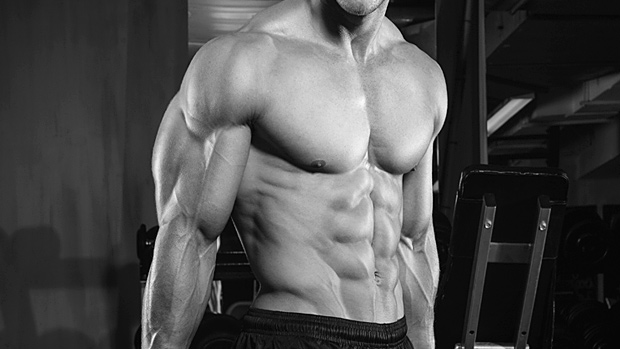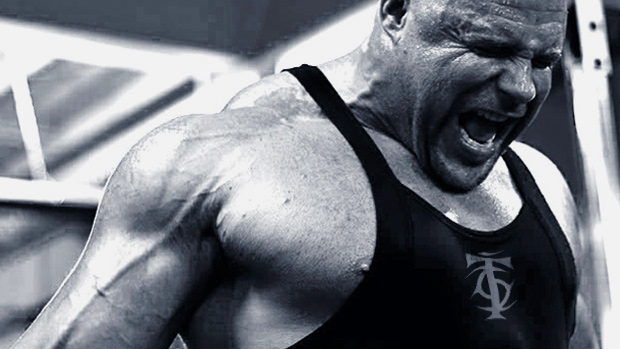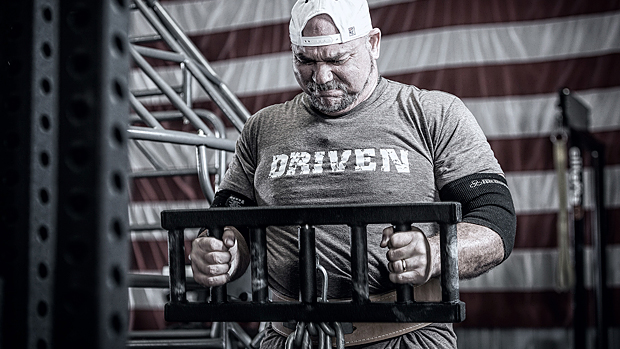The numbers (5-4-3-2-1) represents the sequence and number of sets you'll do for each of the exercises. The exercises that get the most sets (5, 4) are the most complex and tend to use the heaviest loads done for the fewest amount of reps. Therefore, they're placed early in the workout when you're most fresh. The less complex movements (i.e., more isolation oriented) exercises are performed for fewer sets (3, 2, 1) are placed later in the workout. These exercises are done for more reps so we use less weight.
Perform a single arm dumbbell or kettlebell push-press. Once the weight is overhead, slowly lower the weight using a 4-6-second eccentric. The beauty of the exercise is that it enables you to press more weight above your head than you could by just doing a strict shoulder press because you're using your legs to help drive the weight overhead. This allows you to integrate some supramaximal eccentric overload training into the workout because we're stronger eccentrically than concentrically. (As an aside, a 2002 study by Doan found that eccentric overloading improved 1RM concentric performance by 5-15 pounds for all subjects in the study. Not too shabby.)
This exercises also works the core quite well as your torso muscles have to work hard in order to maintain your position in order to counteract the offset load (i.e., holding weight on one side of the body).
This is one of our favorite shoulder pressing variations. It's not only a great way to spice up your shoulder workouts and hit your shoulders a bit differently, but it also requires some additional core muscle engagement in order to maintain the offset load. Although you can certainly perform this exercise using a dumbbell, we prefer to do it with a kettlebell because its design really works well for this exercise.
One of my favorite exercise variations is the superband front raise and pull apart. This comprehensive exercise hits the shoulder musculature several different ways.
You'll be supersetting the previous movement with 3 sets of dumbbell or machine rear-delt fly. I certainly don't need to tell you how to do dumbbell rear delt fly, nor do I need to get into the details of using the rear delt fly machine. However, in order to help you make the most of these exercises, I will mention that fellow T Nation contributor Brad Schoenfeld did a study that investigated the "Effect of hand position on EMG activity of the posterior shoulder musculature during a horizontal abduction exercise" and found that doing the exercise with a neutral hand position worked much better in activating the posterior deltoid and infraspinatus muscles than a pronated hand position.
In other words, when performing the rear-delt fly on a machine, you'll get the most rear delt recruitment using a neutral grip, and it's likely that using a neutral grip when doing dumbbell rear-delt fly will offer the same advantages over the more common thumbs down grip.
You can do the shoulder triple-threat protocol by either using a barbell or holding a pair of dumbbells. As the name implies, it involves three shoulder-intensive exercises performed back to back:
- Upright Row
- Shoulder Press
- Upper-Body Dominant Snatch
The way we perform upright row is by using a wider grip and not by pulling the elbows above shoulder height. Not only do we keep the bar as close to the body as possible, we also pull the bar into the chest at the top. Also, our goal when performing the upper-body dominant snatch in this protocol is to minimize hip drive and the use of your lower body, as this is NOT an Olympic lift. So you Olympic-lifting purists can stop getting your singlet in a bunch – this exercise is used in this protocol to help you crank out a few extra reps to continuously overload the shoulders.
Put simply, you hold one side in an isometric contraction while the other arm moves through a dynamic (concentric and eccentric) movement. You then switch sides.
As you can see, this simple modification not only helps us to create a new training stimulus from a very familiar bodybuilding exercise, it also creates muscular overload by increasing the time under tension (TUT). And, by increasing TUT, you increase metabolic stress, which is one of the 3 mechanisms for increasing muscle hypertrophy.
Although we have evidence that isometric training can be an effective means of adding muscle, the reality is that it's downright boring to perform it through stand-alone sets. It's not very interesting to remain still like a statue for 5 seconds, much less 30-plus seconds. It's because of this reality that we really like iso-dynamic shoulder raise because this exercise application combines both isometric and dynamic reps into the same exercise.
A. One-Arm Push-Press with Eccentric Emphasis: 5 sets x 4-5 reps (each side). Rest 90 seconds between sets (one set = both sides completed).
B. Kettlebell Shoulder-to-Shoulder Press: 4 sets x 6-8 (each side). Rest 90 seconds between sets.
C1. Superband Front Raise plus Pull Apart: 3 sets x 12-15 reps.
C2. Dumbbell or Machine Rear-Delt Fly: 3 sets x 12-15 reps. Rest 90 seconds between paired-sets (one paired set = both exercises completed).
D. Shoulder Triple Threat Protocol: 2 sets x 6-8 reps of each exercise. Rest 2 minutes between sets (one set = one full round through all three exercises).
E. Iso-Dynamic Lateral Raise: 1 x Countdown set. *
* Perform five dynamic reps on your right side while your left side does the isometric hold. Then switch and perform five dynamic reps on your left side while your right side does the isometric hold. You then repeat that same process only doing four dynamic reps on each side while the other side performs the isometric hold. Then repeat the same process, again, only this time doing three reps on each side while the other side performs the asymmetrical. To finish, you perform two reps in a bilateral fashion (i.e., using two arms simultaneously).
- You can use this as a standalone workout if your training split calls for a specific shoulder focused day. Doing this of course will get you in and out of the gym faster than if you train several muscle groups in the same workout.
- If your training split has you training several muscle groups in the same workout, I recommend you perform this workout alongside other smaller muscle groups such as your abdominals or arms, as using it with larger muscle groups such as back maybe too fatiguing.
- If you're not interested in using the specific workout program, you can still benefit by plugging in any of the unique exercise applications and protocols in order to spice up your own workouts and throw some new exercises at your shoulders.





